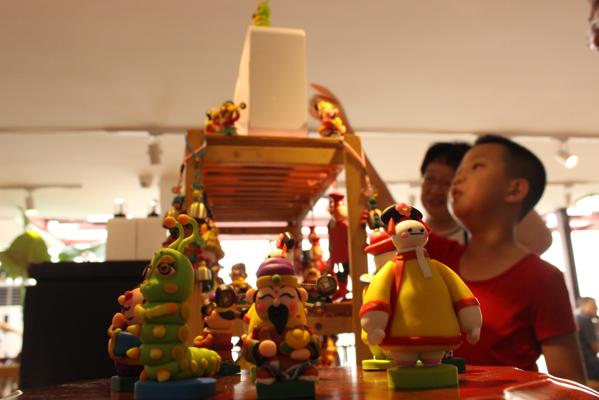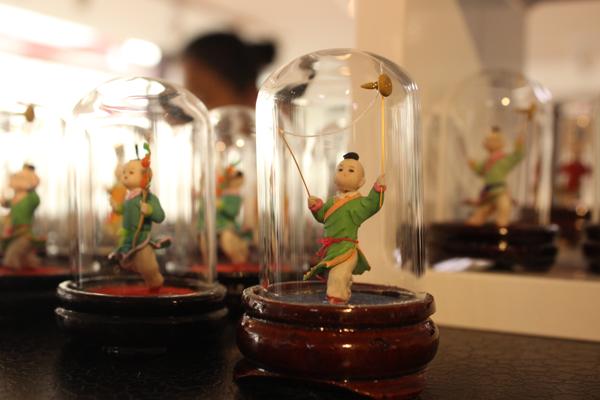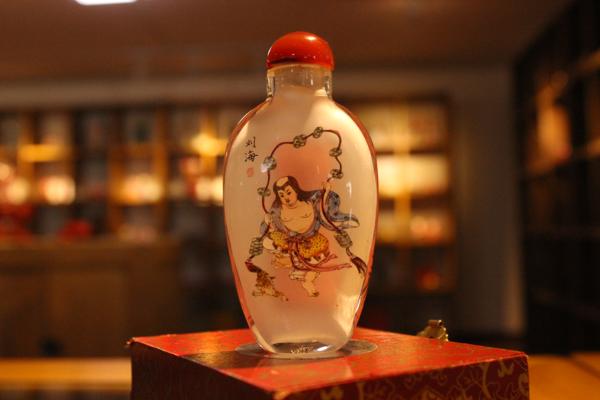
The Nanluoguxiang area in Beijing is a new center for craftsmen to revive cultural heritage such as snuffbox miniature paintings and figurines.[Photo by Wang Kaihao/ China Daily]
Nanluoguxiang, a well-known hutong (alleyway) area of Beijing and home to the nobles of the Qing Dynasty (1644-1911), is seeking to revive its glory.
This month a 700-square-meter two-story old house was turned into an intangible cultural heritage display center there, with experts such as Peng Xiaoping describing the initiative as a milestone for cultural protection in the capital.
“We don’t want to be canaries in the cage,” says Peng, 54, who is listed as an intangible cultural heritage inheritor in Dongcheng district of Beijing, where he makes figurines from dough.
“Intangible cultural heritage isn’t just something that’s enshrined (in museums). We have to step out to get closer to the market.”
He and 14 other inheritors are partners in this newly established Nanluoguxiang studio that will serve as an incubator for their ideas.

[Photo by Wang Kaihao/ China Daily]
Scattered efforts are weak when it comes to applying modern business models to traditional craftsmanship in China, he says. Many elderly artisans complain that young people have little interest in carrying on the work of the older generations.
“But therein lies a truth: Their old ways of running their businesses aren’t profitable enough to attract young blood.”
All partners in the Nanluoguxiang project are not only able to individually sell their products typically reflective of old Beijing lifestyle, including snuffbox miniature paintings, Peking Opera masks and silk figurines, but they are also in the process of creating a common brand to push their art.
Their mascot for the project is Liu Haichan, a 10th century Taoist master, who is considered the god of fortune by many Beijing residents since the Ming Dynasty (1368-1644).
“When talking about the Chinese god of fortune, most people will think of the images popular in southern China,” Peng, a Beijing native, says.
“Few young people in Beijing now know that Liu Haichan was once very popular among families in this city.”

[Photo by Wang Kaihao/ China Daily]
Peng expects that the revitalization of this tradition may also help more Beijing residents get involved in a shared lifestyle in today’s busy world.
Besides, he adds, in this technological age anyone promoting traditional culture needs to be highly creative.
Xu Yan, head of Nanluoguxiang Chamber of Commerce, says the influence of the business model will probably extend beyond one of Beijing’s busiest tourist destinations, which attracts more than 70,000 visitors on Saturdays and on Sundays.
“With Nanluoguxiang’s booming business, property owners will want to continue renting their houses for more such businesses,” he says, and this will keep rents high.
For example, the rent on shop space of 20 square meters would typically be 25,000 yuan ($3,900) a month.
High property prices in the area have stood in the way of the cultural industry there, Xu says, explaining why Nanluoguxiang has changed from a center of culture into an entertainment area lined with food stalls and bars.
In April the Ministry of Housing and Urban-Rural Development and the State Administration of Cultural Heritage jointly announced the names of China’s 30 most significant streets, celebrated for their history and culture. But Nanluoguxiang was not among them.
The authorities cleared more than 70 “low-quality stores” in Nanluoguxiang last year to gain more space for cultural entrepreneurs to rebuild the area’s reputation. The chamber of commerce also invested 60 million yuan in the new intangible cultural heritage studio without charging any rent from Peng or other inheritors.
Instead, a percentage of the revenue from sales will be given to the chamber of commerce.
“This may be a solution to nurture the cultural industry,” Xu says, adding that he is prepared to copy the studio model elsewhere in Nanluoguxiang and expand outside the area, too.
Though government-leading intangible cultural heritage parks are common in China, Xu is considering a long-term mechanism that will make full use of industry bodies and reply more on the market.
“Those parks will be easily influenced by decision-makers’ preferences. The cultural industry needs more persistence,” Xu says.
Whether the Nanluoguxiang experiment works for the revival of Beijing’s lost cultural elements, only time will tell.
